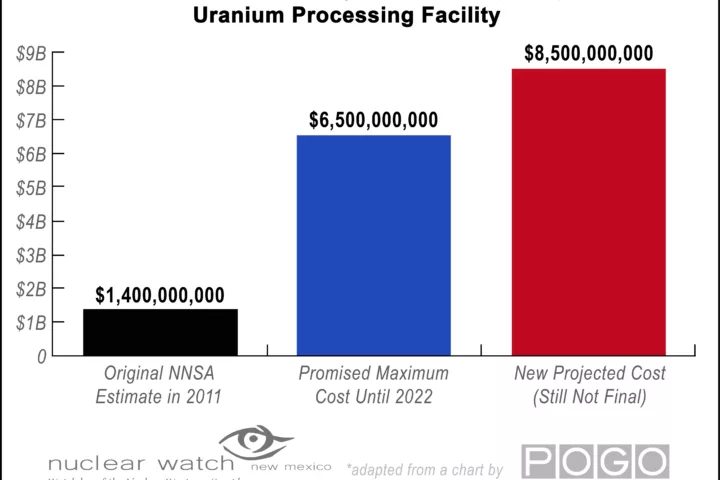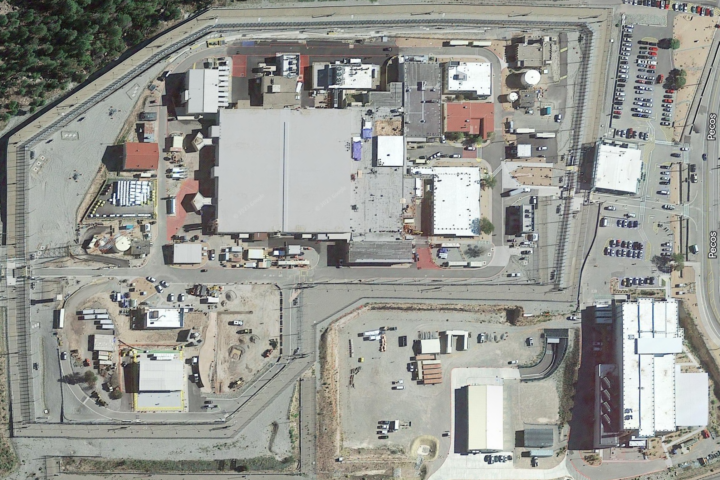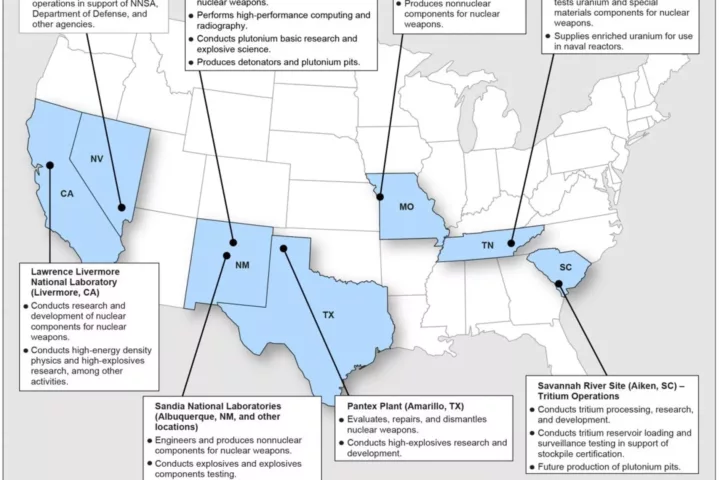Santa Fe, NM – Today, the independent Government Accountability Office (GAO) released a scathing report entitled NNSA Does Not Have a Comprehensive Schedule or Cost Estimate for Pit Production Capability. The National Nuclear Security Administration (NNSA) and its parent Department of Energy have been on the GAO’s High Risk List for project mismanagement since 1991.
Plutonium pits are the essential radioactive cores of nuclear weapons. There has been only limited production at the Los Alamos National Laboratory (LANL) since 1989 when a FBI raid investigating environmental crimes abruptly shut down production at the Rocky Flats Plant near Denver. NNSA now plans to spend $2.9 billion in FY 2023 alone to establish production of at least 30 pits per year at LANL and 50 pits per year at the Savannah River Site (SRS) in South Carolina.
The two main findings of GAO’s report are:
- NNSA’s Plutonium Pit Production Scope of Work Includes Dozens of Programs, Projects, and Other Activities Managed by Multiple NNSA Offices at Multiple Sites (p 19)
As background, NNSA has repeatedly refused to prepare a new programmatic environmental impact statement (PEIS) on expanded plutonium pit production, pursuant to requirements under the National Environmental Policy Act (NEPA) pertaining to “new information or changed circumstances.”
Instead, NNSA claims that a 2008 Complex Transformation Programmatic Environmental Impact Statement is sufficient to meet NEPA requirements. By definition that programmatic EIS is outdated. Further, it did not consider simultaneous pit production at two sites, as NNSA is now planning for LANL and SRS.
Moreover, as the GAO report states, “a fully functional pit production capability relies upon additional programmatic and supporting activities at Livermore [National Laboratory in California], Nevada [National Security Site], Kansas City [Plant in Missouri], Pantex [Plant in Texas], and WIPP [the Waste Isolation Pilot Plant in southern New Mexico for radioactive waste disposal].” (p. 31) This makes the case why NNSA must complete a new, nationwide programmatic environmental impact statement on expanded plutonium pit production.
In June 2021 the citizen groups Tri-Valley CAREs, Savannah River Site Watch and Nuclear Watch New Mexico sued NNSA to compel it to complete a new PEIS.[1] This GAO report lends strong support to our lawsuit.
- NNSA Does Not Have a Comprehensive Schedule or Cost Estimate for Establishing its Pit Production Capability (p. 40)
In its preface, GAO notes that “Reestablishing pit production likely represents NNSA’s largest investment in weapons production infrastructure to date.”
The GAO report goes on to say:
“The schedule NNSA developed and identified as an integrated master schedule includes some activities managed under its Plutonium Modernization program. However, this schedule captures only some sites’ activities through the FPU [First Production Unit] in 2024—not all activities or milestones to achieve an 80-pit-per-year production capability… As a result, NNSA’s pit production schedule is not comprehensive… it cannot be considered reliable… NNSA has also not provided any other overall cost estimate for its effort to establish an 80-pit-per-year production capability.” (p. 40)
In 2018 NNSA projected a life cycle cost over 30 years for pit production of $43 billion. Since that time, the estimated cost for the pit production plant at SRS has more than doubled to $11 billion. Including sunk costs of ~$7 billion for the failed MOX Fuel Fabrication Facility (which NNSA is “repurposing” to pit production), it will likely cost more than $20 billion, making it the second most expensive building in human history (in comparison the new World Trade Center cost ~$4 billion).
In all, pit production at both LANL and SRS will cost at least $60 billion over 30 years, and likely far more. Indirect costs (radioactive waste disposal, clean up, threats to drinking water supplies, worker illnesses, etc.) could be as much. Pit production will produce around 1,000 cubic meters of new radioactive wastes each year for the next 50 years. It is doubtful that New Mexico’s Waste Isolation Pilot Plant will have the capacity to dispose of 50,000 cubic meters of new radioactive wastes. The potential costs of fueling a new nuclear arms race are incalculable.
In addition to its enormous expense, expanded plutonium pit production is unnecessary and may actually degrade national security because:
- According to independent experts (known as the JASONs), plutonium pits have serviceable lives of at least a century. There is no estimated expiration date. At least 15,000 existing pits are already stored at the Pantex Plant near Amarillo, TX.
- No future pit production is to maintain the safety and reliability of the existing nuclear weapons stockpile. Future pits may significantly deviate from original, tested designs.
- Future pit production is for speculative new-design nuclear weapons (the W87-1 and W93 warheads). They are obviously bad international proliferation examples. In addition, they cannot be full-scale tested because of the existing testing moratorium, thereby perhaps eroding confidence in stockpile reliability. Or, arguably worse yet, they could prompt the U.S. back into testing, which would have severe international proliferation consequences.
Pit production at the Savannah River Site was originally scheduled to begin in 2030 but is now delayed until 2035 or longer. This will likely increase pressure on the Los Alamos Lab to implement planned “surge capacity” of production of up to 80 pits per year, which is questionable under any circumstances.
LANL’s plutonium facility “PF-4” was built in the mid-1970’s as a research, not production, facility. Major plutonium operations at PF-4 were halted for more than three years because of repeated nuclear safety incidences, which still have not been fully resolved. PF-4 does not conform to modern seismic standards. Moreover, other dangerous plutonium operations compete for floor space at PF-4, including the planned processing of up to 40 metric tons of “excess” plutonium.
Jay Coghlan, Nuclear Watch New Mexico Director, commented, “Given the enormous costs and downsides of expanded plutonium pit production, Congress, and in particular the New Mexican delegation, should demand that NNSA provide credible cost estimates and schedules for expanded plutonium pit production. Until then, Congress should stop rewarding the guilty with yet more money. That is simple good governance that could help slow our sleepwalk into the new and unpredictable nuclear arms race.”
# # #
GAO’s report NNSA Does Not Have a Comprehensive Schedule or Cost Estimate for Pit Production Capability is available at https://www.gao.gov/products/gao-23-104661
This press release is available at https://nukewatch.org/press-release-item/gao-pit-pr-1-12-23/
[1] We currently await a court decision on NNSA’s Motion to Dismiss. For more on our lawsuit see https://www.scelp.org/cases/plutonium-pits



